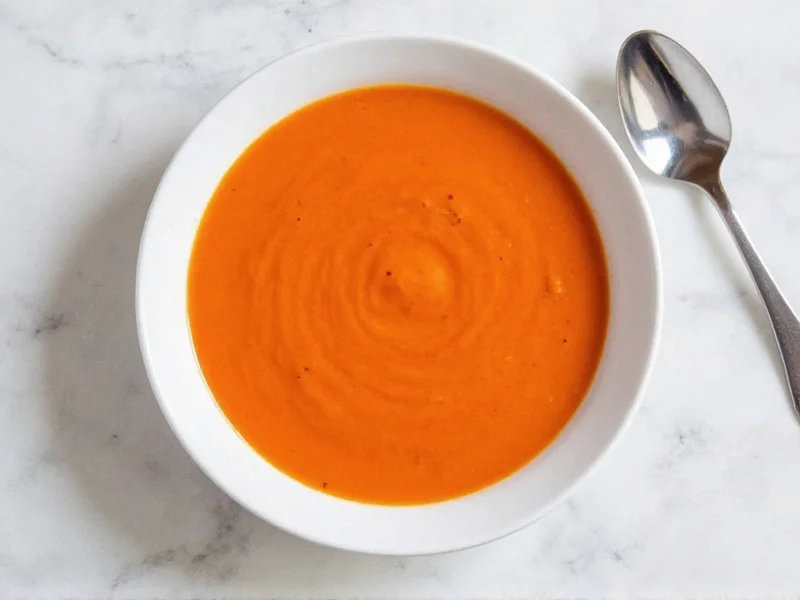Understanding Tomato Bisque: More Than Just Creamy Tomato Soup
When exploring what is tomato bisque soup, it's essential to recognize its distinctive qualities that set it apart from ordinary tomato preparations. This elegant soup represents a culinary tradition that transforms simple ingredients into something extraordinary through specific preparation techniques.
The Defining Characteristics of Authentic Tomato Bisque
Several elements distinguish true tomato bisque from standard tomato soup. The most notable difference between tomato bisque and tomato soup lies in texture and preparation. While regular tomato soup might be chunky or blended but not refined, bisque undergoes a meticulous straining process to achieve its signature silkiness.
Traditional tomato bisque ingredients typically include ripe tomatoes, onions, carrots, celery, garlic, tomato paste, broth, cream or milk, and aromatic herbs like thyme and bay leaves. The addition of cream is essential, but what truly defines bisque is the careful reduction and straining process that creates its luxurious mouthfeel.
Historical Origins: From Seafood to Tomato Delight
The term “bisque” has fascinating historical roots. Originally, bisques were rich, creamy soups made from shellfish, particularly crayfish or lobster. French chefs developed these soups by grinding shellfish shells with cream to extract maximum flavor and create a smooth texture.
Over time, the preparation method was adapted to other ingredients, including tomatoes. By the early 20th century, tomato bisque had become a staple in American and European cuisine, appearing frequently in cookbooks and restaurant menus. The evolution from seafood-based preparations to vegetable-based versions demonstrates culinary innovation while maintaining the essential bisque characteristics.
What Makes Tomato Bisque Creamy: Beyond Just Adding Dairy
Many home cooks mistakenly believe that simply adding cream to tomato soup creates bisque. However, the creaminess of authentic tomato bisque comes from multiple factors:
| Element | Role in Creating Creaminess |
|---|---|
| Tomato Reduction | Slow cooking concentrates flavors and natural pectins |
| Vegetable Base | Caramelized onions, carrots, and celery add body |
| Straining Process | Removes all solids for ultra-smooth texture |
| Cream Incorporation | Adds richness but isn't the sole source of smoothness |
| Optional Roux | Some traditional recipes use flour-based thickener |
Preparation Techniques That Define Authentic Bisque
The preparation method is what truly separates tomato bisque from ordinary tomato soup. Authentic preparation involves several key steps:
- Sweating aromatics: Gently cooking onions, carrots, and celery without browning
- Tomato reduction: Cooking down tomatoes with tomato paste to intensify flavor
- Slow simmering: Allowing flavors to meld over low heat
- Meticulous straining: Passing through fine mesh sieve or chinois
- Cream integration: Adding dairy at the end to prevent curdling
- Final seasoning: Adjusting salt, acidity, and herbs after straining
Common Variations and Modern Interpretations
While traditional tomato bisque follows specific preparation guidelines, numerous variations exist that maintain the essential bisque characteristics while introducing creative elements:
- Roasted tomato bisque: Using oven-roasted tomatoes for deeper flavor
- Herb-infused versions: Adding basil, oregano, or tarragon during cooking
- Spiced interpretations: Incorporating smoked paprika or cayenne for complexity
- Dairy-free alternatives: Using coconut milk or cashew cream for vegan versions
- Garnish innovations: Croutons, pesto swirls, or fresh herb toppings
Serving Traditions and Pairing Suggestions
Tomato bisque is traditionally served hot as a first course. Its vibrant color and smooth texture make it visually appealing in white or cream-colored bowls. Classic pairings include:
- Cheesy grilled sandwiches (particularly with cheddar or gruyere)
- Crusty artisan bread for dipping
- Simple green salads with vinaigrette dressing
- Oyster crackers or homemade croutons as garnish
The soup's acidity balances well with rich, fatty elements, making grilled cheese the quintessential companion. For more formal settings, chefs often present tomato bisque with elegant garnishes that complement rather than overwhelm its delicate flavor profile.
Nutritional Profile and Dietary Considerations
Tomato bisque offers several nutritional benefits while containing moderate calories due to its cream content. A standard serving (about 1 cup) typically contains:
- Approximately 150-250 calories depending on cream content
- Rich in lycopene from tomatoes, a powerful antioxidant
- Good source of vitamin C and potassium
- Contains vitamin A from tomato and vegetable components
- Provides some dietary fiber from vegetable base
For those seeking lighter versions, many chefs create tomato bisque without heavy cream while maintaining texture through reduction and careful straining. Understanding what makes tomato bisque creamy helps in developing satisfying lower-calorie alternatives.
Identifying Authentic Tomato Bisque in Restaurants
When dining out, certain characteristics indicate you're experiencing genuine tomato bisque rather than simply creamed tomato soup:
- Perfectly smooth texture with no discernible vegetable pieces
- Rich, complex flavor that balances acidity and sweetness
- Velvety mouthfeel that coats the spoon
- Vibrant red-orange color without being artificially bright
- Subtle seasoning that enhances rather than masks tomato flavor
Unfortunately, many establishments serve what they label as “bisque” that lacks the defining preparation elements. Knowing the difference between tomato bisque and tomato soup helps consumers identify authentic preparations.











 浙公网安备
33010002000092号
浙公网安备
33010002000092号 浙B2-20120091-4
浙B2-20120091-4